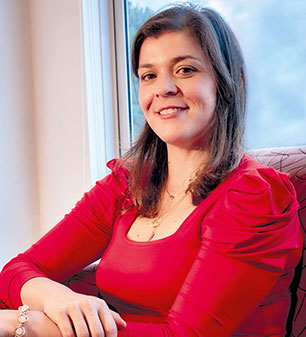New digital narratives: the venture of specialized journalism
By: Ximena Serrano Gil
Photos:
Science and Tech

By: Ximena Serrano Gil
Photos:
Journalists, the media, the scientific community, and society in general had to learn in real time about COVID-19. The information barrage and poor quality of the information released by social networks and the media exposed the weaknesses in the way we report on health, which turned the misinformation into a true pandemic.
Since the new coronavirus (SARS-CoV-2) came to light, it has been common to find data, figures, and statistics without context or reliable sources, flooding the already crowded digital universe.
This oversaturation of information (some strict and some fake) gave rise to the term ‘infodemic’.
The lack of the training of journalists and communicators to address health issues, the scarcity of specialized media, and the need to report fake news deepened the information crisis.
In this scenario, journalists and professors Fátima Martínez Gutiérrez and Juliana Colussi, from the Programa de Journalism and Public Opinion Program of the School of Human Sciences of the Universidad del Rosario, specializing in digital journalism and new media, decided to study which media in Latin America were doing something different from just publishing figures and the number of casualties, as they considered that there were issues that were not being deeply addressed: “These were all sad stories told in macro data, but there was no information on health in journalism, there was no specialization,” said the professors
In this search, Martínez and Colussi, Spanish and Brazilian, respectively, came across Salud con Lupa, a digital native media (exclusively available online) specialized in health, which covers Latin American countries such as Peru, Brazil, and Colombia. Founded by Peruvian journalist Fabiola Torres, on July 9, 2019, it is a pioneering collaborative journalism site in the region and intended for a wide readership, which aspires to change the paradigm of what everyone considers public health.
According to the approach of the founder of this digital platform, “public health is not about medical journalism, and it is not only about science outreach; health must be understood from a different perspective.” Aspects such as the cost of medicines, inequality in access to services, the prevention and control of chronic diseases, and legal and political provisions are the parts of this environment.
Within this media context, the journalists, conducted with an overwhelming emotion the study Specialized digital journalism in Latin America: an analysis of the coverage of coronavirus in the digital media Salud Con Lupa, a research that was published in the book Jornalismo em tempos da pandemia do novo coronavírus (Journalism in times of the pandemic of the new coronavirus) (Ria Editorial, 2020)
The research analyzed the coverage that the media conducted in the first half of 2020 about the COVID-19 pandemic, with the main goal of verifying the types and approaches of the published content.
“It was very important to see if they told stories beyond the data, so in addition to analyzing the content, we also looked at what stories they told and how they told them; what type of information they provided, whether it was informative or more interpretative and involved more than just figures; whether they contained graphic support, such as infographics, and how creative their narrative was,” said Colussi.
One thing that caught their attention, says Martínez, was that the platform was created shortly before the pandemic, and while many media were closing down or firing journalists, Salud con Lupa took advantage of the crisis to receive economic resources, gain an audience, and consolidate itself as a transnational media in the midst of the health emergency, thus imposing its own agenda of investigative journalism in public health in Latin America.
Martínez Gutiérrez in his article "Health in the digital age", published in the book "How digital technologies are influencing information in health. Evcents, sources and routines of communication professionals", by the Universidad de Nebrija (Spain), argues how social media has become one of the main sources of scientific information, according to the IX survey on the social perception of science in Spain, issued by the Spanish Foundation for Science and Technology (Fecyt, for its Spanish acronym). This is how today, journalists, patients, and the consumers of information are joined together through virtuality, which in turn becomes the best ally for innovation and the creation of new media.
Meanwhile, Antonio Calvo Roy, the president of the Spanish Association of Science Communication (AECC for its Spanish acronym), in his paper"Health information in world 3.0”; this paper is a part of the same publication of the Nebrija University, states that from the point of view of journalism practice, hyper connection is nothing more than an accumulation of advantages that can facilitate the work (...). Maintaining strictness, contrasting information, and keeping a journalistic sense to select the right topics are elements that differentiate a professional journalist from an amateur one.
This argument, which can be applied to any type of journalism, becomes more complicated in times of information instability when infodemics prevail. Thus, in times of pandemics, checking data, verifying sources, and reporting with responsibility become even more necessary challenges for the practice of journalism related to health.
Such challenges were undertaken with professionalism Salud con Lupa, as the experts found it a media with collaborating journalists from all over Latin America, where they approached issues from other story narratives and other topics such as pandemic corruption, which were not being addressed in the traditional national or international media. “In general, we found more contextualized topics, supported by infographics, to overcome misinformation. The content was rigorous, careful, thoughtful, and in depth,” explained the two researchers.

Juliana Colussi, a professor at the School of Human Sciences of the Universidad del Rosario, explains that when the pandemic was declared, both in Colombia and in most of Latin American countries, the general media did not promote a critical or informative debate to generate a plural and open dialog, perhaps due to a lack of knowledge or lack of training.
When the pandemic was declared, both in Colombia and in most Latin American countries, the general media did not promote a critical or informative debate that would generate an open dialog, perhaps due to a lack of knowledge or a lack of training. According to Juliana Colussi, issues related to the coronavirus or vaccines were addressed very lightly, with an almost governmental approach where they only published what government sources said; there was no objective or investigative journalism, unlike what Salud con Lupa did report to its readers.
An example of this is the obvious media show that governments made with vaccination, which was promoted by the media in Latin America. On the one hand, there were revenues and political marketing, and on the other hand, journalists who, seeking to fill in the gaps, volunteered to do so.
“The lack of depth and analysis on public health is owing to the lack of specialization in scientific journalism and health by journalists who cover these topics. In universities, there is no such thing as a health field of studies. After what we have experienced during this year and after the coronavirus, there will be a change in the way of covering public health issues,” emphasized Fátima Martínez, a former director of Plaza Capital, a digital media of the Universidad del Rosario.
In the study, the creator of Salud con Lupa, Fabiola Torres, adds that “learning to become informed about health is not an easy task, and journalism has not offered truly valuable information, focused on service, that really explains the issues.”
Fighting the misinformation about COVID-19 that is released by digital media, including social media, is a need that implies a paradigm shift and greater strictness in journalistic work. In this sense, journalists almost become information detectives, and, as the experts point out, “the pandemic emphasizes the need to generate good health information in the media, where it is observed that there is a lack of Hispanic media on public health research for the average reader.”
With more emphasis, journalists Fátima and Juliana pointed out that to do health and science journalism, it is necessary to be trained and acquire tools. It takes time; the journalist must research and read a lot to be able to interview and know how to search for and compare information. In that sense, immediate journalism for social media undermines journalism in depth.
For this reason, this study acquires special relevance when concluding that Salud con Lupa is imposing a new journalistic style and format that is characterized by informative content prioritizing a variety of topics related to COVID-19, where collaborating journalists address the different issues, contextualize the content, and humanize the stories to allow a greater understanding of the information by the citizens.
Some examples highlighted by the researchers were Perú: weaknesses in the Ministry of health's platform expose information on COVID-19 patients, which, beyond the figures, highlights the problem of the Government’s obligation to protect patient data privacy of all Peruvians.
Another example, related to pharmaceuticals, is the piece entitled “ Monopoly: three promising COVID-19 drugs have exclusive rights," which shows how several COVID-19 treatments are protected by patents that restrict access to them by citizens despite being strongly financed with public funds.
Most recently, the #GrowWithoutParents series of interviews on the emotional impact on children orphaned by the coronavirus. Since the beginning of the pandemic “approximately 11,000 Peruvian children and teenagers have lost their parents.”
The journalists of Salud con Lupa emphasized the importance of delving further into science, understanding that figures without context are meaningless, using virtuality to foster collaborative work, maintaining critical and investigative thought, and innovating in the new digital narratives.
It is a fact that the ways and styles of providing information have changed; the consumption of content goes at a faster pace than the contagion of the virus itself. Moreover, although digital dynamics facilitate the spread of journalistic information, they also spread fake news. Thus, to the extent that there is greater specialization, both in the media and among journalists, we can ensure a true democratization of knowledge through journalism solutions that may become the remedy against misinformation.

“The lack of depth and analysis on public health is due to the lack of specialization in science and health journalism by journalists to cover these topics. There is no field of studies about health in universities,” says Fátima Martínez, a professor at the School of Human Sciences of the Universidad de Rosario.